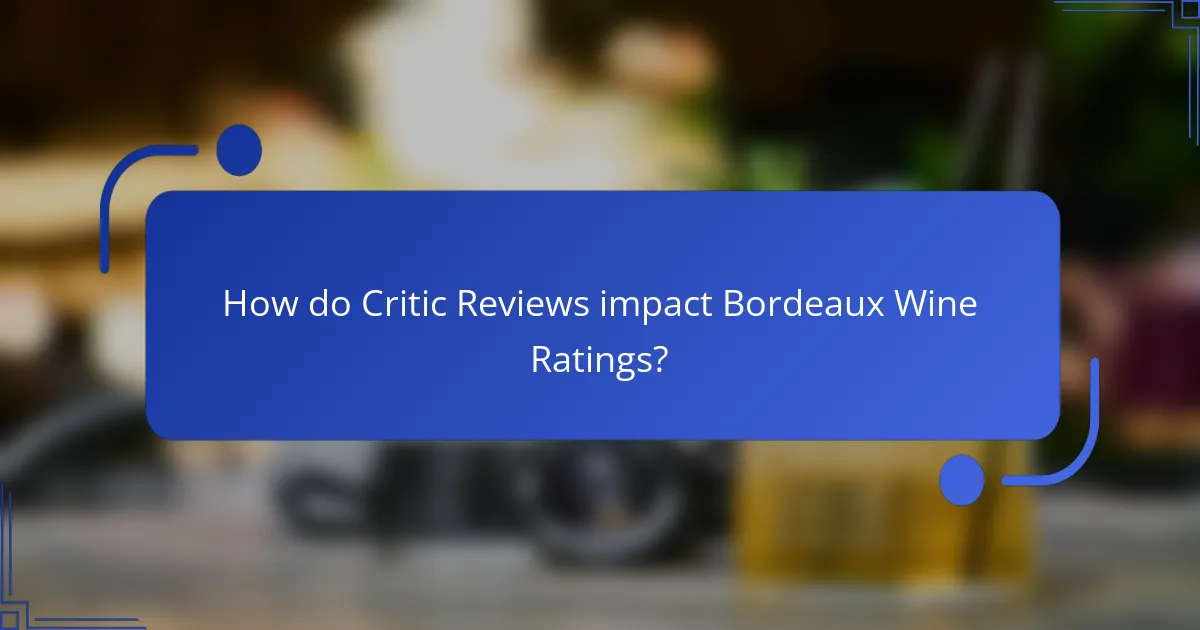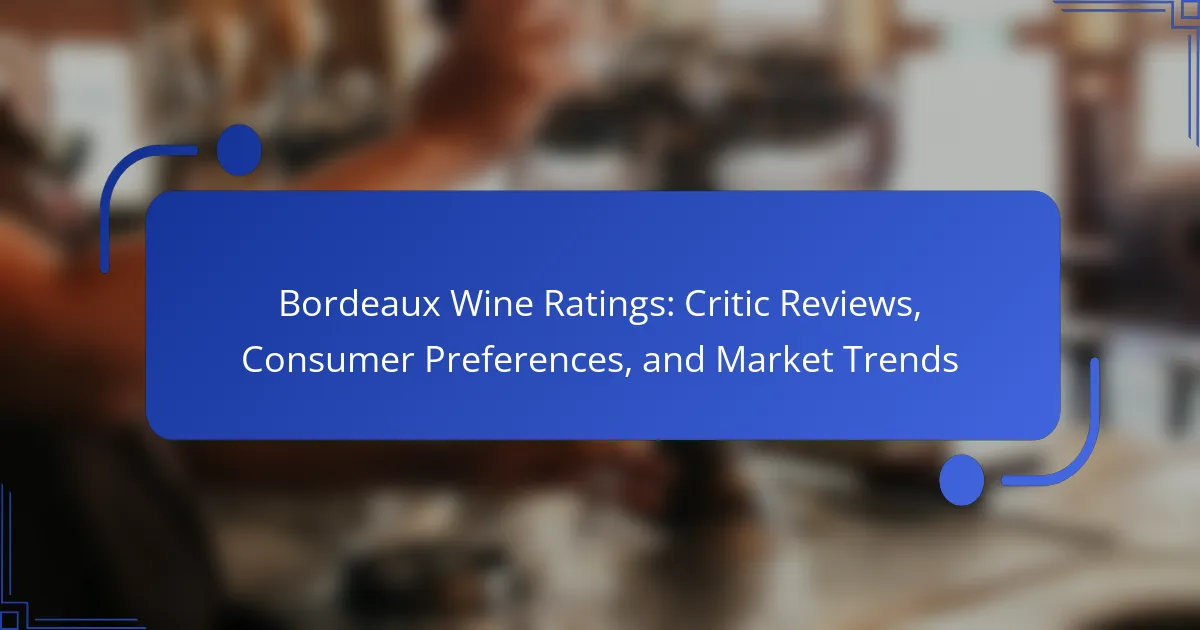
What are Bordeaux Wine Ratings?
Bordeaux Wine Ratings are evaluations assigned to wines from the Bordeaux region of France. These ratings assess the quality and potential of the wines based on various factors. Critics and wine experts typically conduct these evaluations. Ratings often range from 1 to 100, with higher scores indicating superior quality. The Bordeaux Wine Official Classification of 1855 is a historical benchmark for these ratings. It categorized wines into five growths, based on quality and reputation. Modern critics, such as Robert Parker, also influence Bordeaux wine ratings significantly. Their scores can impact market demand and pricing for these wines.
How are Bordeaux Wine Ratings determined?
Bordeaux wine ratings are determined through a combination of expert reviews and scoring systems. Wine critics evaluate factors such as flavor, aroma, and balance. The Bordeaux wine classification system also plays a crucial role. This system categorizes wines based on their quality and reputation. The 1855 classification remains influential today. Ratings often use a numerical scale, typically ranging from 1 to 100. Higher scores indicate superior quality. Consumer preferences and market trends further influence these ratings. Collectively, these elements guide wine enthusiasts in their purchasing decisions.
What criteria do critics use to evaluate Bordeaux wines?
Critics evaluate Bordeaux wines based on several key criteria. These criteria include appearance, aroma, taste, and finish. Appearance assesses the wine’s color and clarity. Aroma evaluates the complexity and intensity of the wine’s scent. Taste involves the balance of sweetness, acidity, and tannins. Finish refers to the aftertaste and length of flavor. Critics also consider the wine’s ageability and overall quality. These factors help determine the wine’s rating and market value.
Who are the most influential critics in Bordeaux wine ratings?
The most influential critics in Bordeaux wine ratings include Robert Parker, Jancis Robinson, and James Suckling. Robert Parker is known for his 100-point rating system, which has significantly impacted wine valuation. Jancis Robinson is a respected wine critic and author, recognized for her extensive knowledge and contributions to wine literature. James Suckling, a former editor of Wine Spectator, has a large following for his wine reviews and scores. These critics shape consumer preferences and market trends through their ratings and reviews. Their influence is evident in auction prices and consumer buying behaviors.
What is the significance of Bordeaux Wine Ratings?
Bordeaux Wine Ratings are significant because they influence consumer purchasing decisions. These ratings provide a standardized assessment of wine quality. They are often based on expert reviews from wine critics. High ratings can enhance a wine’s market value significantly. For instance, wines rated 90 points or higher often see increased demand. This demand can lead to higher prices at auctions and retail. Additionally, Bordeaux Wine Ratings help consumers navigate a vast selection of wines. They serve as a trusted guide for both novice and experienced wine drinkers. Overall, these ratings play a crucial role in the wine industry, affecting sales and reputation.
How do ratings influence consumer purchasing decisions?
Ratings significantly influence consumer purchasing decisions by shaping perceptions of product quality. High ratings often lead to increased trust in a product. This trust can result in higher sales and brand loyalty. For instance, a study found that 70% of consumers are influenced by online reviews when making purchases. Furthermore, products with higher ratings are more likely to be chosen over those with lower ratings. In the context of Bordeaux wines, critics’ ratings can elevate a wine’s market value. This correlation between ratings and purchasing behavior underscores the importance of perceived quality in consumer choices.
What role do ratings play in the Bordeaux wine market?
Ratings significantly influence the Bordeaux wine market. They serve as a benchmark for quality assessment. High ratings can enhance a wine’s reputation and increase demand. Conversely, low ratings may lead to decreased interest and sales. Ratings from reputable critics like Robert Parker are particularly impactful. They often dictate pricing and market trends. For instance, wines rated above 90 points typically command higher prices. This correlation between ratings and consumer behavior shapes purchasing decisions in the market.

How do Critic Reviews impact Bordeaux Wine Ratings?
Critic reviews significantly influence Bordeaux wine ratings. These reviews provide expert evaluations of wine quality, which consumers often rely on for purchasing decisions. High ratings from reputable critics can enhance a wine’s market value and demand. Conversely, negative reviews may diminish a wine’s reputation and sales potential. According to a study published in the Journal of Wine Economics, wines rated 90 points or higher saw price increases of up to 30%. This demonstrates the direct correlation between critic reviews and market performance. Additionally, critics often set benchmarks that shape consumer expectations and preferences in the Bordeaux wine market.
What are the common themes in critic reviews of Bordeaux wines?
Common themes in critic reviews of Bordeaux wines include balance, complexity, and aging potential. Critics often highlight the balance of fruit, acidity, and tannins in these wines. Complexity is frequently noted, with many Bordeaux wines showcasing layered flavors and aromas. Aging potential is a recurring theme, as many critics emphasize the ability of Bordeaux wines to improve with time. Additionally, terroir plays a significant role in reviews, with critics discussing the influence of specific regions and vineyards. Consistency across vintages is also a common point, with critics noting the reliability of top Bordeaux producers. Overall, these themes reflect the quality and reputation of Bordeaux wines in the global market.
How do critics assess the quality and flavor profiles of Bordeaux wines?
Critics assess the quality and flavor profiles of Bordeaux wines through systematic tasting and evaluation. They analyze attributes such as aroma, taste, acidity, tannin structure, and finish. Critics often use a scoring system to quantify their assessments. Common scales range from 1 to 100 points. The Wine Advocate and Wine Spectator are notable publications that provide these ratings. Critics also consider the wine’s vintage, terroir, and producer reputation. Historical context and market trends influence their evaluations. For instance, a 2015 Bordeaux vintage received high praise for its balance and complexity. This methodical approach ensures a comprehensive understanding of Bordeaux wines.
What are the most frequently mentioned attributes in Bordeaux wine reviews?
The most frequently mentioned attributes in Bordeaux wine reviews include aroma, flavor, body, tannins, acidity, and finish. Reviews often highlight the complex aromas, such as dark fruit, oak, and spices. Flavor descriptions frequently include notes of blackberry, plum, and chocolate. The body of the wine is commonly noted as full or medium. Tannins are described as firm or soft, affecting the wine’s texture. Acidity levels are also mentioned, influencing the wine’s freshness. Lastly, the finish is often characterized as long or short, impacting the overall experience. These attributes help consumers and critics assess the quality and style of Bordeaux wines.
How do critic reviews differ from consumer preferences?
Critic reviews often emphasize technical aspects of wine, while consumer preferences focus on personal taste. Critics assess quality based on established standards, such as aroma, flavor, and structure. They may prioritize certain attributes like complexity and aging potential. In contrast, consumers may prefer wines that are more approachable and enjoyable to drink. Research indicates that consumers often value price and brand reputation more than critics do. For example, a study by the Wine Market Council found that 62% of consumers consider price when choosing wine, while critics may overlook this factor in their evaluations. This divergence highlights that critics and consumers prioritize different attributes in their assessments of Bordeaux wines.
What insights can be gained from comparing critic reviews to consumer ratings?
Comparing critic reviews to consumer ratings provides insights into differing perspectives on Bordeaux wines. Critics often focus on technical attributes and stylistic nuances. Their reviews may highlight complexities that consumers might overlook. Conversely, consumer ratings reflect personal enjoyment and accessibility. This can reveal trends in popularity that may not align with expert opinions. For example, a wine rated highly by critics may receive lower consumer ratings if it is perceived as too complex or expensive. Analyzing these differences can help producers understand market demands. It also aids consumers in making informed purchasing decisions based on a balance of expert and peer feedback.
How do personal preferences shape consumer ratings of Bordeaux wines?
Personal preferences significantly influence consumer ratings of Bordeaux wines. Factors such as taste, aroma, and price play crucial roles in shaping these preferences. Individual experiences and cultural backgrounds also affect how consumers perceive wine quality. For instance, a consumer who enjoys fruity flavors may rate a Bordeaux higher if it aligns with their taste. Additionally, familiarity with certain Bordeaux brands can lead to biased ratings based on past experiences. Research indicates that consumers often prioritize personal enjoyment over expert reviews when rating wines. Therefore, personal preferences create a subjective framework that impacts overall consumer ratings of Bordeaux wines.

What are the current market trends for Bordeaux Wines?
Current market trends for Bordeaux wines indicate a rising demand for premium and organic selections. Sales of Bordeaux wines have seen a significant increase in Asian markets, particularly in China. The trend towards sustainability has led to a growing interest in biodynamic and organic Bordeaux wines. Additionally, younger consumers are increasingly seeking out unique and lesser-known Bordeaux producers. The global wine market is shifting towards online sales, with Bordeaux wines benefiting from this trend. According to the Bordeaux Wine Council, exports of Bordeaux wines reached €2.7 billion in 2022, highlighting their strong international appeal. Overall, Bordeaux wines are adapting to consumer preferences for quality, sustainability, and accessibility.
How do market trends affect Bordeaux Wine Ratings?
Market trends significantly influence Bordeaux wine ratings. Changes in consumer demand can shift the perception of quality. For instance, a surge in popularity for organic wines can elevate ratings for Bordeaux wines that meet this criterion. Additionally, economic factors, such as a recession, may lead to lower ratings for wines as consumers prioritize affordability. The influence of critics also plays a crucial role. If a prominent critic highlights a particular vintage, market trends may follow, enhancing its rating. Historical data shows that vintages rated highly often see increased market demand, further validating the ratings. Thus, market trends directly correlate with the ratings assigned to Bordeaux wines.
What recent trends have emerged in the Bordeaux wine market?
Recent trends in the Bordeaux wine market include a growing preference for organic and biodynamic wines. Consumers are increasingly seeking sustainability in their purchases. There is also a rise in interest for lesser-known Bordeaux appellations. This trend diversifies consumer choices beyond the traditional top names. Additionally, wine investment is gaining popularity, particularly in fine wines. The Bordeaux market has seen increased prices for high-quality vintages. Digital platforms for purchasing and tasting experiences have expanded. These trends reflect changing consumer values and market dynamics.
How do economic factors influence Bordeaux wine ratings and sales?
Economic factors significantly influence Bordeaux wine ratings and sales. Economic conditions affect consumer purchasing power and demand for luxury goods like Bordeaux wine. When the economy is strong, consumers are more likely to spend on high-quality wines, leading to higher ratings and increased sales. Conversely, during economic downturns, consumers may opt for lower-priced alternatives, negatively impacting both ratings and sales.
Additionally, exchange rates can affect international sales. A stronger euro can make Bordeaux wines more expensive for foreign buyers, potentially reducing sales volume. Conversely, favorable exchange rates can boost foreign demand and ratings. Market trends, such as the rise of online wine sales, also play a role in economic influences. Increased accessibility can enhance sales, reflecting positively on ratings as more consumers engage with Bordeaux wines.
Overall, economic factors create a dynamic environment that shapes both the ratings and sales of Bordeaux wines.
What consumer preferences are shaping the Bordeaux wine market?
Consumer preferences shaping the Bordeaux wine market include a growing demand for organic and sustainable wines. Many consumers now prioritize environmentally friendly practices in wine production. Additionally, there is an increasing interest in lower-alcohol wines. This trend aligns with health-conscious choices among wine drinkers. Furthermore, consumers are showing preference for unique varietals over traditional blends. This shift reflects a desire for diverse tasting experiences. Lastly, younger consumers are influencing the market with their inclination towards digital purchasing and social media engagement. These preferences are reshaping marketing strategies and product offerings in the Bordeaux wine sector.
What are the most popular styles and varieties of Bordeaux wines among consumers?
The most popular styles and varieties of Bordeaux wines among consumers are red blends, white Bordeaux, and rosé. Red Bordeaux wines, primarily made from Cabernet Sauvignon and Merlot, dominate the market. These wines are known for their rich flavors and aging potential. White Bordeaux, often a blend of Sauvignon Blanc and Sémillon, is appreciated for its crispness and versatility. Rosé from Bordeaux, which has gained popularity, offers refreshing fruit flavors. According to the Bordeaux Wine Council, red wines account for approximately 85% of Bordeaux production, highlighting their consumer preference.
How do age and demographic factors influence consumer preferences for Bordeaux wines?
Age and demographic factors significantly influence consumer preferences for Bordeaux wines. Younger consumers tend to favor fruity and approachable wines. They often prefer wines that are marketed with modern branding and social media presence. In contrast, older consumers typically appreciate traditional Bordeaux characteristics, such as complexity and aging potential.
Demographics also play a role; higher-income individuals often seek premium Bordeaux wines. They are more likely to invest in fine wines for special occasions. Additionally, cultural background can influence taste preferences. For instance, consumers from regions with a strong wine culture may prefer classic Bordeaux styles.
Research indicates that millennials are driving demand for sustainable and organic wines. This demographic shift is reshaping marketing strategies in the Bordeaux wine industry. Overall, understanding age and demographic factors helps producers tailor their offerings to meet diverse consumer preferences.
What are the best practices for interpreting Bordeaux Wine Ratings?
To interpret Bordeaux Wine Ratings effectively, focus on understanding the scoring systems used by critics. Many critics employ a 100-point scale, where higher scores indicate better quality. Familiarize yourself with the specific criteria that critics consider, such as aroma, flavor, body, and aging potential.
Contextualize ratings by considering the vintage year, as climatic conditions greatly influence wine quality. Compare ratings from multiple sources to gain a balanced perspective. Recognize that personal taste plays a significant role; a highly rated wine may not suit everyone’s palate.
Lastly, consider the reputation of the critic or publication providing the rating, as established critics often have consistent standards. By applying these practices, you can make informed decisions when selecting Bordeaux wines.
How can consumers effectively use wine ratings to guide their purchases?
Consumers can effectively use wine ratings by understanding the scoring system and the context of the reviews. Wine ratings typically use a numerical scale, often from 1 to 100, where higher scores indicate better quality. Consumers should compare ratings from multiple reputable sources to get a balanced view. Ratings should be considered alongside tasting notes that describe flavors and aromas. This helps consumers align their preferences with the wine’s profile. Additionally, consumers can look for consistent ratings from the same critics over time. This consistency can indicate a reliable quality standard. Understanding the vintage and region can also enhance the relevance of the ratings. Bordeaux wines, for example, may vary significantly by year, impacting their ratings.
What common pitfalls should consumers avoid when relying on Bordeaux wine ratings?
Consumers should avoid over-reliance on single ratings when evaluating Bordeaux wine. Ratings from different critics can vary significantly. This inconsistency can lead to misguided purchasing decisions. Additionally, consumers often overlook the context of ratings, such as the vintage year. A high rating does not guarantee personal enjoyment. Consumers should also be cautious of trends influencing ratings, as popularity can overshadow quality. Furthermore, relying solely on ratings can neglect the importance of personal taste preferences. Lastly, consumers may fail to consider the provenance and storage conditions of the wine, which can greatly affect its quality.
Bordeaux Wine Ratings are evaluations that assess the quality of wines from the Bordeaux region in France, primarily influenced by critics and expert reviews. This article explores how these ratings are determined, the criteria used for evaluation, and the impact of influential critics like Robert Parker. Additionally, it examines the significance of ratings in consumer purchasing decisions and market trends, including the growing demand for organic wines and the influence of economic factors. Insights into consumer preferences and best practices for interpreting ratings are also discussed, providing a comprehensive understanding of the Bordeaux wine market.
